Comprehensive Analysis of Audi's Operations, Logistics & Supply Chain
VerifiedAdded on 2023/01/11
|10
|2828
|56
Report
AI Summary
This report provides a comprehensive analysis of Audi's operations, logistics, and supply chain management. It begins with an introduction to these concepts, emphasizing their importance in coordinating the flow of materials, goods, and information from origin to consumption. The report then delves into the key components of supply chain, logistics, and operations management within Audi, highlighting issues related to product development. It examines Audi's operational functions, including production, scheduling, and transformation processes, as well as the significance of logistics management. The report addresses challenges such as fluctuating building times, supply chain disruptions, and the need for efficient delivery systems. It also explores new product development, strategic planning, supplier strategies, and the importance of performance measures. The report concludes by discussing quality management, emphasizing the tools and practices Audi can use to improve its product quality and overall operational efficiency.
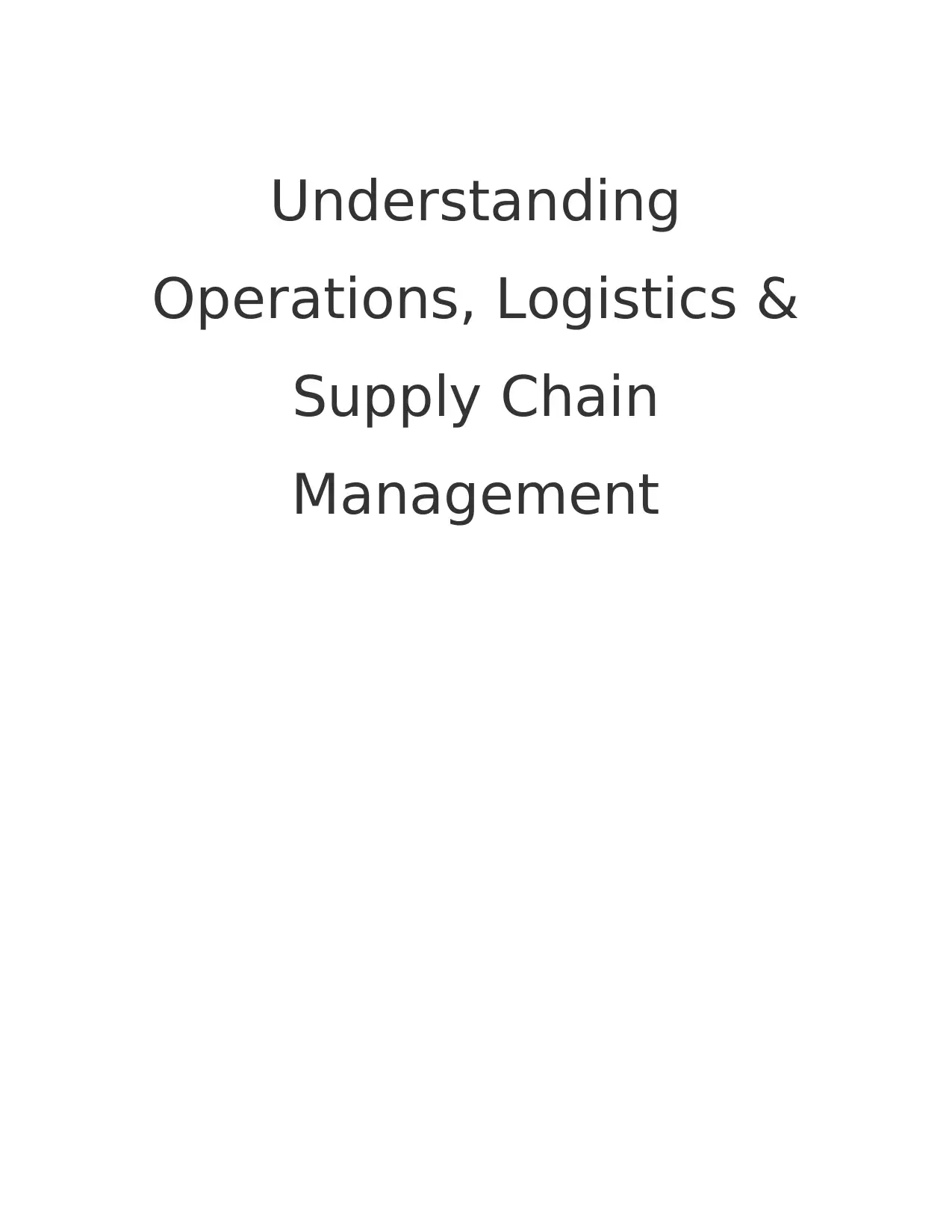
Understanding
Operations, Logistics &
Supply Chain
Management
Operations, Logistics &
Supply Chain
Management
Paraphrase This Document
Need a fresh take? Get an instant paraphrase of this document with our AI Paraphraser

INTRODUCTION...........................................................................................................................1
REFERENCES................................................................................................................................8
REFERENCES................................................................................................................................8
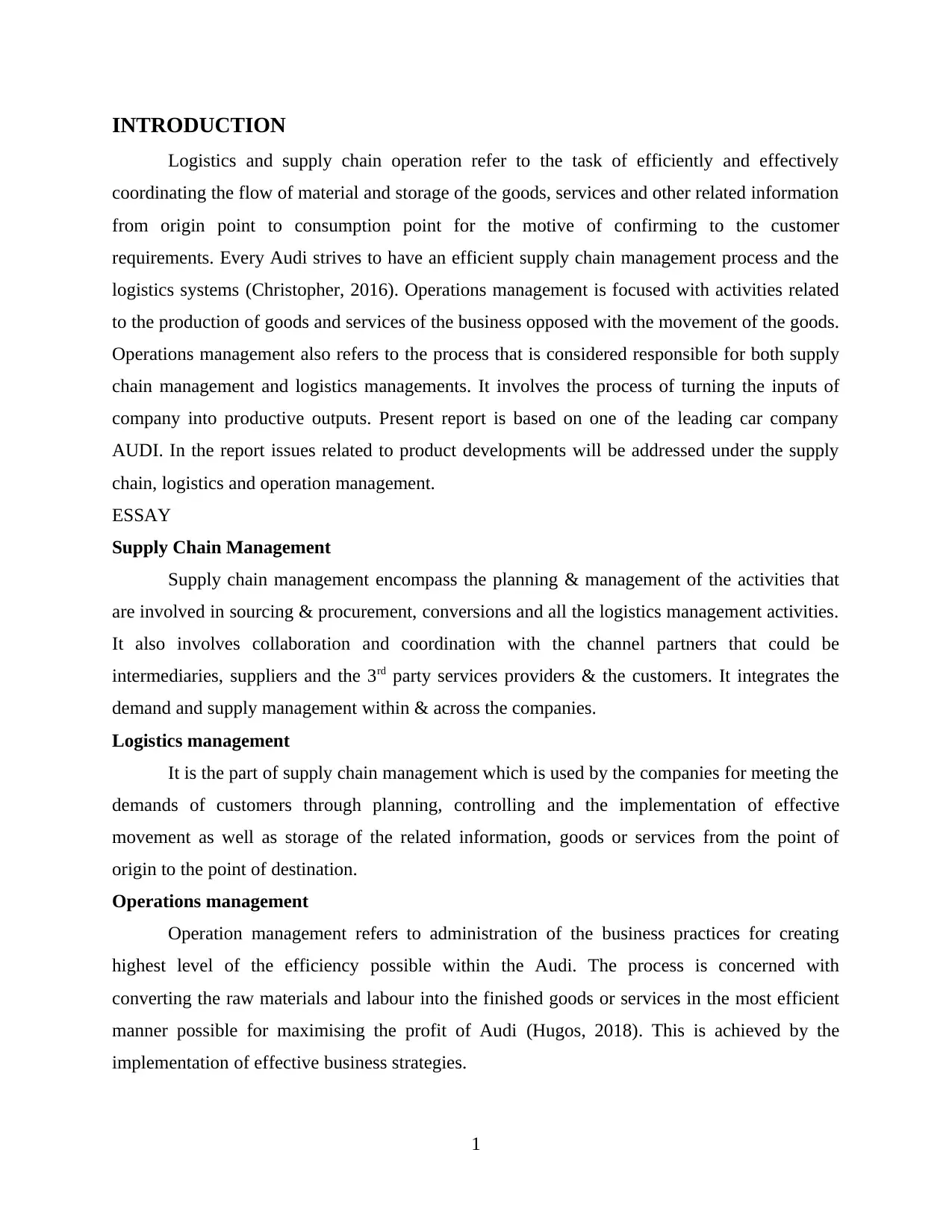
INTRODUCTION
Logistics and supply chain operation refer to the task of efficiently and effectively
coordinating the flow of material and storage of the goods, services and other related information
from origin point to consumption point for the motive of confirming to the customer
requirements. Every Audi strives to have an efficient supply chain management process and the
logistics systems (Christopher, 2016). Operations management is focused with activities related
to the production of goods and services of the business opposed with the movement of the goods.
Operations management also refers to the process that is considered responsible for both supply
chain management and logistics managements. It involves the process of turning the inputs of
company into productive outputs. Present report is based on one of the leading car company
AUDI. In the report issues related to product developments will be addressed under the supply
chain, logistics and operation management.
ESSAY
Supply Chain Management
Supply chain management encompass the planning & management of the activities that
are involved in sourcing & procurement, conversions and all the logistics management activities.
It also involves collaboration and coordination with the channel partners that could be
intermediaries, suppliers and the 3rd party services providers & the customers. It integrates the
demand and supply management within & across the companies.
Logistics management
It is the part of supply chain management which is used by the companies for meeting the
demands of customers through planning, controlling and the implementation of effective
movement as well as storage of the related information, goods or services from the point of
origin to the point of destination.
Operations management
Operation management refers to administration of the business practices for creating
highest level of the efficiency possible within the Audi. The process is concerned with
converting the raw materials and labour into the finished goods or services in the most efficient
manner possible for maximising the profit of Audi (Hugos, 2018). This is achieved by the
implementation of effective business strategies.
1
Logistics and supply chain operation refer to the task of efficiently and effectively
coordinating the flow of material and storage of the goods, services and other related information
from origin point to consumption point for the motive of confirming to the customer
requirements. Every Audi strives to have an efficient supply chain management process and the
logistics systems (Christopher, 2016). Operations management is focused with activities related
to the production of goods and services of the business opposed with the movement of the goods.
Operations management also refers to the process that is considered responsible for both supply
chain management and logistics managements. It involves the process of turning the inputs of
company into productive outputs. Present report is based on one of the leading car company
AUDI. In the report issues related to product developments will be addressed under the supply
chain, logistics and operation management.
ESSAY
Supply Chain Management
Supply chain management encompass the planning & management of the activities that
are involved in sourcing & procurement, conversions and all the logistics management activities.
It also involves collaboration and coordination with the channel partners that could be
intermediaries, suppliers and the 3rd party services providers & the customers. It integrates the
demand and supply management within & across the companies.
Logistics management
It is the part of supply chain management which is used by the companies for meeting the
demands of customers through planning, controlling and the implementation of effective
movement as well as storage of the related information, goods or services from the point of
origin to the point of destination.
Operations management
Operation management refers to administration of the business practices for creating
highest level of the efficiency possible within the Audi. The process is concerned with
converting the raw materials and labour into the finished goods or services in the most efficient
manner possible for maximising the profit of Audi (Hugos, 2018). This is achieved by the
implementation of effective business strategies.
1
⊘ This is a preview!⊘
Do you want full access?
Subscribe today to unlock all pages.

Trusted by 1+ million students worldwide
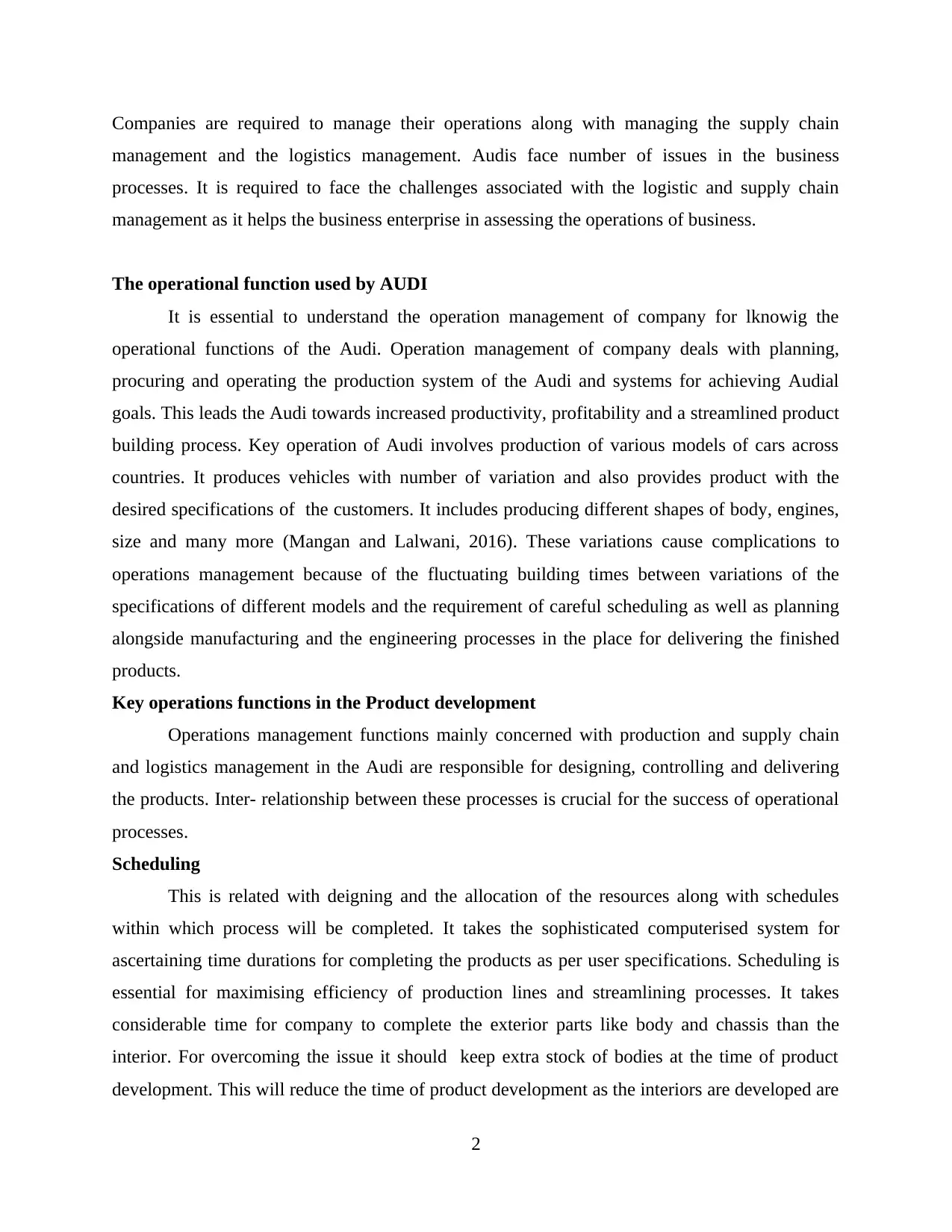
Companies are required to manage their operations along with managing the supply chain
management and the logistics management. Audis face number of issues in the business
processes. It is required to face the challenges associated with the logistic and supply chain
management as it helps the business enterprise in assessing the operations of business.
The operational function used by AUDI
It is essential to understand the operation management of company for lknowig the
operational functions of the Audi. Operation management of company deals with planning,
procuring and operating the production system of the Audi and systems for achieving Audial
goals. This leads the Audi towards increased productivity, profitability and a streamlined product
building process. Key operation of Audi involves production of various models of cars across
countries. It produces vehicles with number of variation and also provides product with the
desired specifications of the customers. It includes producing different shapes of body, engines,
size and many more (Mangan and Lalwani, 2016). These variations cause complications to
operations management because of the fluctuating building times between variations of the
specifications of different models and the requirement of careful scheduling as well as planning
alongside manufacturing and the engineering processes in the place for delivering the finished
products.
Key operations functions in the Product development
Operations management functions mainly concerned with production and supply chain
and logistics management in the Audi are responsible for designing, controlling and delivering
the products. Inter- relationship between these processes is crucial for the success of operational
processes.
Scheduling
This is related with deigning and the allocation of the resources along with schedules
within which process will be completed. It takes the sophisticated computerised system for
ascertaining time durations for completing the products as per user specifications. Scheduling is
essential for maximising efficiency of production lines and streamlining processes. It takes
considerable time for company to complete the exterior parts like body and chassis than the
interior. For overcoming the issue it should keep extra stock of bodies at the time of product
development. This will reduce the time of product development as the interiors are developed are
2
management and the logistics management. Audis face number of issues in the business
processes. It is required to face the challenges associated with the logistic and supply chain
management as it helps the business enterprise in assessing the operations of business.
The operational function used by AUDI
It is essential to understand the operation management of company for lknowig the
operational functions of the Audi. Operation management of company deals with planning,
procuring and operating the production system of the Audi and systems for achieving Audial
goals. This leads the Audi towards increased productivity, profitability and a streamlined product
building process. Key operation of Audi involves production of various models of cars across
countries. It produces vehicles with number of variation and also provides product with the
desired specifications of the customers. It includes producing different shapes of body, engines,
size and many more (Mangan and Lalwani, 2016). These variations cause complications to
operations management because of the fluctuating building times between variations of the
specifications of different models and the requirement of careful scheduling as well as planning
alongside manufacturing and the engineering processes in the place for delivering the finished
products.
Key operations functions in the Product development
Operations management functions mainly concerned with production and supply chain
and logistics management in the Audi are responsible for designing, controlling and delivering
the products. Inter- relationship between these processes is crucial for the success of operational
processes.
Scheduling
This is related with deigning and the allocation of the resources along with schedules
within which process will be completed. It takes the sophisticated computerised system for
ascertaining time durations for completing the products as per user specifications. Scheduling is
essential for maximising efficiency of production lines and streamlining processes. It takes
considerable time for company to complete the exterior parts like body and chassis than the
interior. For overcoming the issue it should keep extra stock of bodies at the time of product
development. This will reduce the time of product development as the interiors are developed are
2
Paraphrase This Document
Need a fresh take? Get an instant paraphrase of this document with our AI Paraphraser
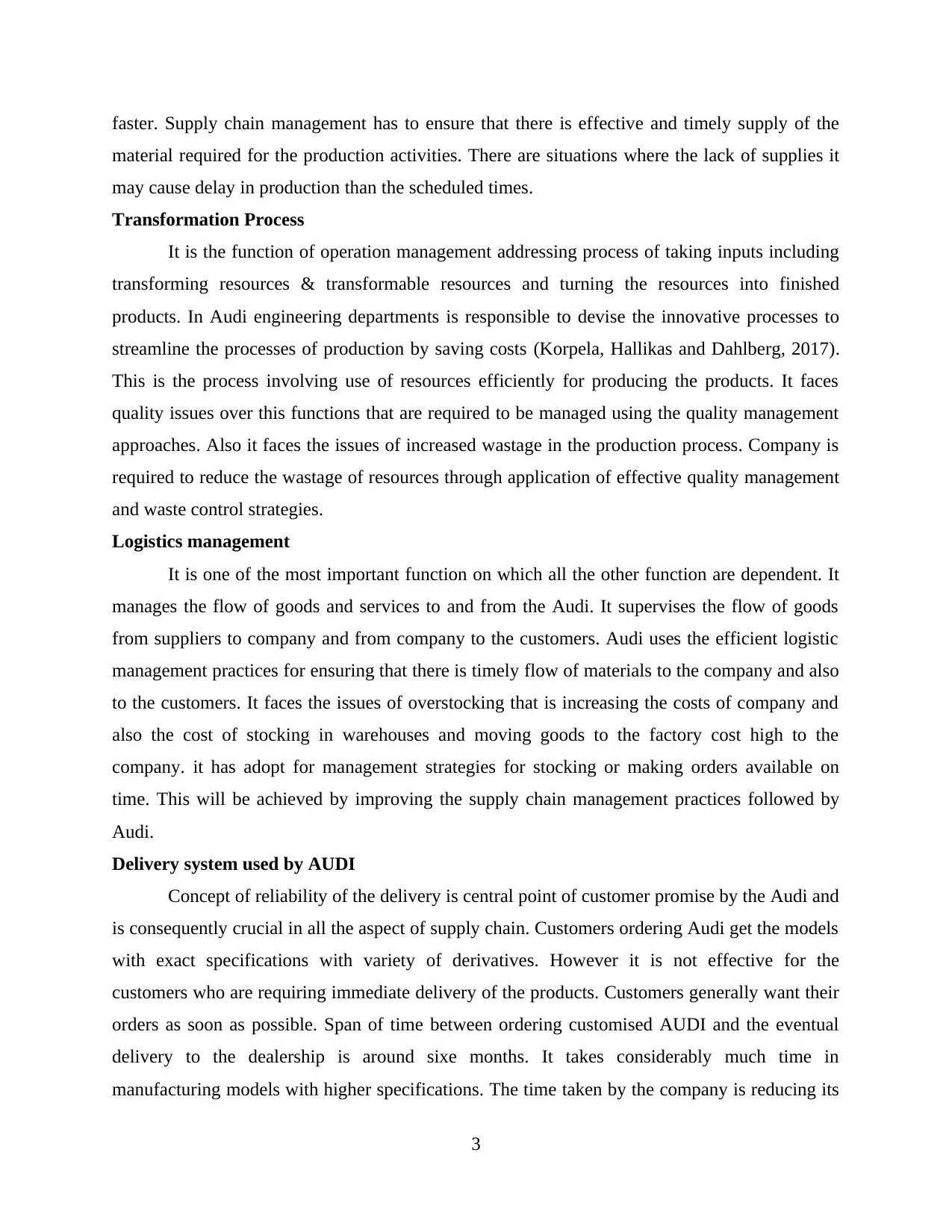
faster. Supply chain management has to ensure that there is effective and timely supply of the
material required for the production activities. There are situations where the lack of supplies it
may cause delay in production than the scheduled times.
Transformation Process
It is the function of operation management addressing process of taking inputs including
transforming resources & transformable resources and turning the resources into finished
products. In Audi engineering departments is responsible to devise the innovative processes to
streamline the processes of production by saving costs (Korpela, Hallikas and Dahlberg, 2017).
This is the process involving use of resources efficiently for producing the products. It faces
quality issues over this functions that are required to be managed using the quality management
approaches. Also it faces the issues of increased wastage in the production process. Company is
required to reduce the wastage of resources through application of effective quality management
and waste control strategies.
Logistics management
It is one of the most important function on which all the other function are dependent. It
manages the flow of goods and services to and from the Audi. It supervises the flow of goods
from suppliers to company and from company to the customers. Audi uses the efficient logistic
management practices for ensuring that there is timely flow of materials to the company and also
to the customers. It faces the issues of overstocking that is increasing the costs of company and
also the cost of stocking in warehouses and moving goods to the factory cost high to the
company. it has adopt for management strategies for stocking or making orders available on
time. This will be achieved by improving the supply chain management practices followed by
Audi.
Delivery system used by AUDI
Concept of reliability of the delivery is central point of customer promise by the Audi and
is consequently crucial in all the aspect of supply chain. Customers ordering Audi get the models
with exact specifications with variety of derivatives. However it is not effective for the
customers who are requiring immediate delivery of the products. Customers generally want their
orders as soon as possible. Span of time between ordering customised AUDI and the eventual
delivery to the dealership is around sixe months. It takes considerably much time in
manufacturing models with higher specifications. The time taken by the company is reducing its
3
material required for the production activities. There are situations where the lack of supplies it
may cause delay in production than the scheduled times.
Transformation Process
It is the function of operation management addressing process of taking inputs including
transforming resources & transformable resources and turning the resources into finished
products. In Audi engineering departments is responsible to devise the innovative processes to
streamline the processes of production by saving costs (Korpela, Hallikas and Dahlberg, 2017).
This is the process involving use of resources efficiently for producing the products. It faces
quality issues over this functions that are required to be managed using the quality management
approaches. Also it faces the issues of increased wastage in the production process. Company is
required to reduce the wastage of resources through application of effective quality management
and waste control strategies.
Logistics management
It is one of the most important function on which all the other function are dependent. It
manages the flow of goods and services to and from the Audi. It supervises the flow of goods
from suppliers to company and from company to the customers. Audi uses the efficient logistic
management practices for ensuring that there is timely flow of materials to the company and also
to the customers. It faces the issues of overstocking that is increasing the costs of company and
also the cost of stocking in warehouses and moving goods to the factory cost high to the
company. it has adopt for management strategies for stocking or making orders available on
time. This will be achieved by improving the supply chain management practices followed by
Audi.
Delivery system used by AUDI
Concept of reliability of the delivery is central point of customer promise by the Audi and
is consequently crucial in all the aspect of supply chain. Customers ordering Audi get the models
with exact specifications with variety of derivatives. However it is not effective for the
customers who are requiring immediate delivery of the products. Customers generally want their
orders as soon as possible. Span of time between ordering customised AUDI and the eventual
delivery to the dealership is around sixe months. It takes considerably much time in
manufacturing models with higher specifications. The time taken by the company is reducing its
3
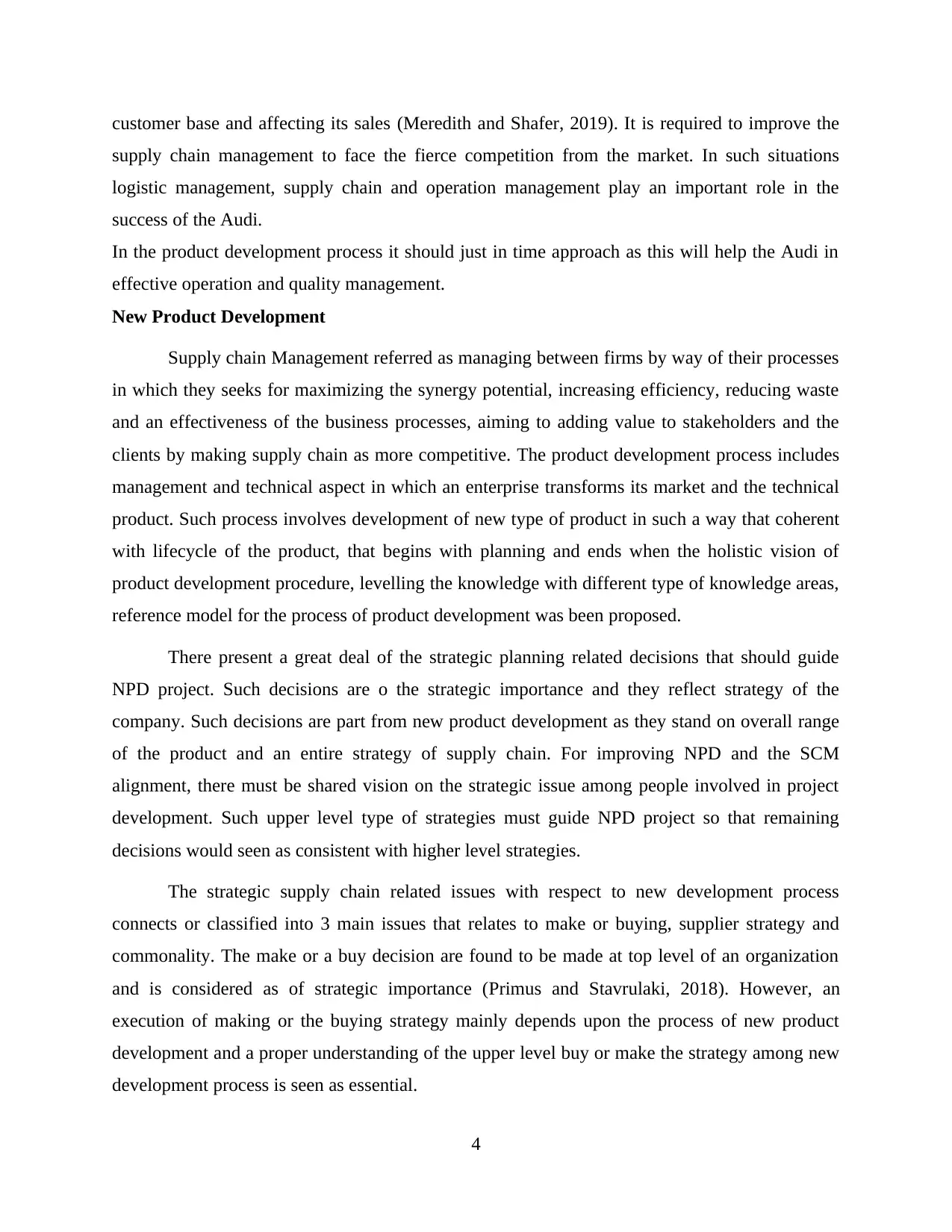
customer base and affecting its sales (Meredith and Shafer, 2019). It is required to improve the
supply chain management to face the fierce competition from the market. In such situations
logistic management, supply chain and operation management play an important role in the
success of the Audi.
In the product development process it should just in time approach as this will help the Audi in
effective operation and quality management.
New Product Development
Supply chain Management referred as managing between firms by way of their processes
in which they seeks for maximizing the synergy potential, increasing efficiency, reducing waste
and an effectiveness of the business processes, aiming to adding value to stakeholders and the
clients by making supply chain as more competitive. The product development process includes
management and technical aspect in which an enterprise transforms its market and the technical
product. Such process involves development of new type of product in such a way that coherent
with lifecycle of the product, that begins with planning and ends when the holistic vision of
product development procedure, levelling the knowledge with different type of knowledge areas,
reference model for the process of product development was been proposed.
There present a great deal of the strategic planning related decisions that should guide
NPD project. Such decisions are o the strategic importance and they reflect strategy of the
company. Such decisions are part from new product development as they stand on overall range
of the product and an entire strategy of supply chain. For improving NPD and the SCM
alignment, there must be shared vision on the strategic issue among people involved in project
development. Such upper level type of strategies must guide NPD project so that remaining
decisions would seen as consistent with higher level strategies.
The strategic supply chain related issues with respect to new development process
connects or classified into 3 main issues that relates to make or buying, supplier strategy and
commonality. The make or a buy decision are found to be made at top level of an organization
and is considered as of strategic importance (Primus and Stavrulaki, 2018). However, an
execution of making or the buying strategy mainly depends upon the process of new product
development and a proper understanding of the upper level buy or make the strategy among new
development process is seen as essential.
4
supply chain management to face the fierce competition from the market. In such situations
logistic management, supply chain and operation management play an important role in the
success of the Audi.
In the product development process it should just in time approach as this will help the Audi in
effective operation and quality management.
New Product Development
Supply chain Management referred as managing between firms by way of their processes
in which they seeks for maximizing the synergy potential, increasing efficiency, reducing waste
and an effectiveness of the business processes, aiming to adding value to stakeholders and the
clients by making supply chain as more competitive. The product development process includes
management and technical aspect in which an enterprise transforms its market and the technical
product. Such process involves development of new type of product in such a way that coherent
with lifecycle of the product, that begins with planning and ends when the holistic vision of
product development procedure, levelling the knowledge with different type of knowledge areas,
reference model for the process of product development was been proposed.
There present a great deal of the strategic planning related decisions that should guide
NPD project. Such decisions are o the strategic importance and they reflect strategy of the
company. Such decisions are part from new product development as they stand on overall range
of the product and an entire strategy of supply chain. For improving NPD and the SCM
alignment, there must be shared vision on the strategic issue among people involved in project
development. Such upper level type of strategies must guide NPD project so that remaining
decisions would seen as consistent with higher level strategies.
The strategic supply chain related issues with respect to new development process
connects or classified into 3 main issues that relates to make or buying, supplier strategy and
commonality. The make or a buy decision are found to be made at top level of an organization
and is considered as of strategic importance (Primus and Stavrulaki, 2018). However, an
execution of making or the buying strategy mainly depends upon the process of new product
development and a proper understanding of the upper level buy or make the strategy among new
development process is seen as essential.
4
⊘ This is a preview!⊘
Do you want full access?
Subscribe today to unlock all pages.

Trusted by 1+ million students worldwide
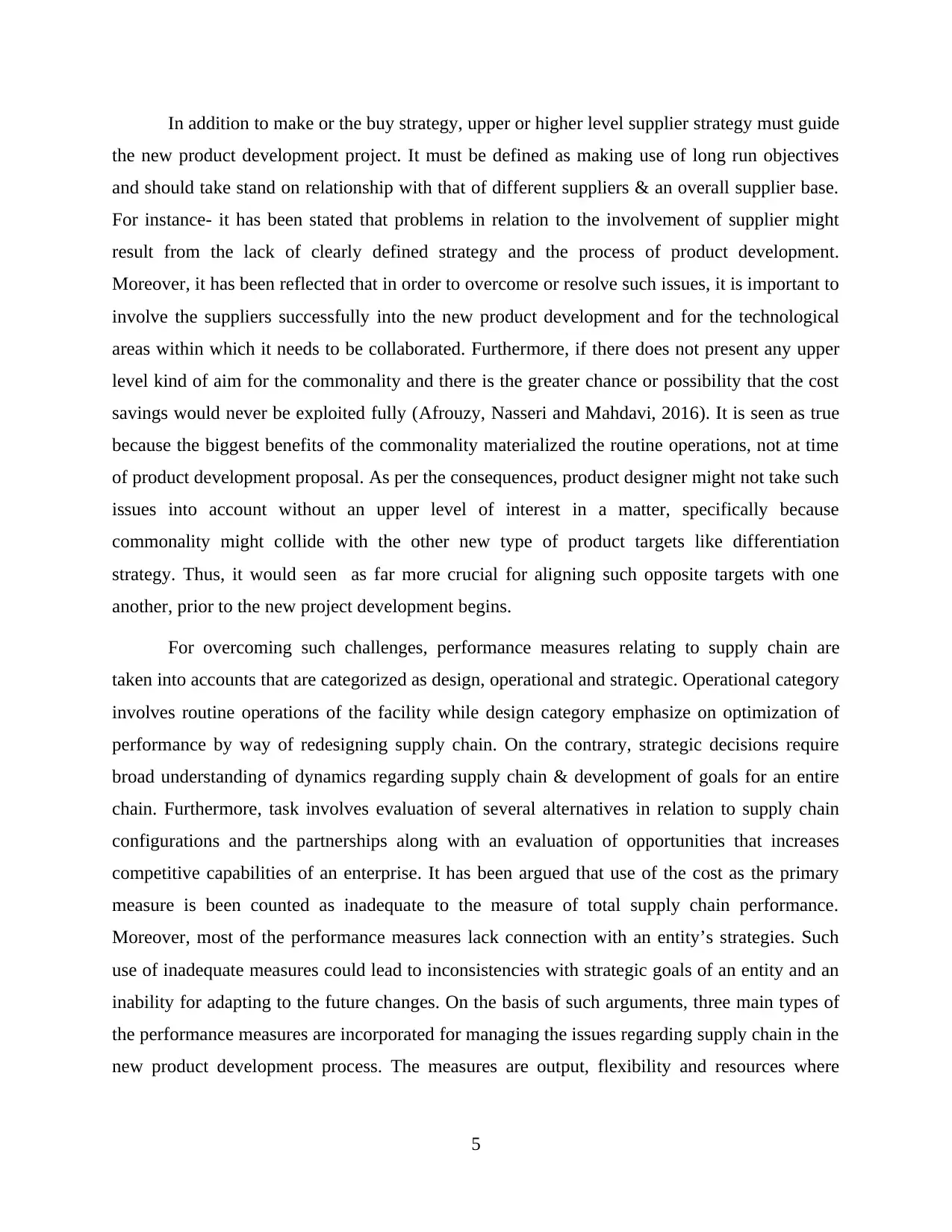
In addition to make or the buy strategy, upper or higher level supplier strategy must guide
the new product development project. It must be defined as making use of long run objectives
and should take stand on relationship with that of different suppliers & an overall supplier base.
For instance- it has been stated that problems in relation to the involvement of supplier might
result from the lack of clearly defined strategy and the process of product development.
Moreover, it has been reflected that in order to overcome or resolve such issues, it is important to
involve the suppliers successfully into the new product development and for the technological
areas within which it needs to be collaborated. Furthermore, if there does not present any upper
level kind of aim for the commonality and there is the greater chance or possibility that the cost
savings would never be exploited fully (Afrouzy, Nasseri and Mahdavi, 2016). It is seen as true
because the biggest benefits of the commonality materialized the routine operations, not at time
of product development proposal. As per the consequences, product designer might not take such
issues into account without an upper level of interest in a matter, specifically because
commonality might collide with the other new type of product targets like differentiation
strategy. Thus, it would seen as far more crucial for aligning such opposite targets with one
another, prior to the new project development begins.
For overcoming such challenges, performance measures relating to supply chain are
taken into accounts that are categorized as design, operational and strategic. Operational category
involves routine operations of the facility while design category emphasize on optimization of
performance by way of redesigning supply chain. On the contrary, strategic decisions require
broad understanding of dynamics regarding supply chain & development of goals for an entire
chain. Furthermore, task involves evaluation of several alternatives in relation to supply chain
configurations and the partnerships along with an evaluation of opportunities that increases
competitive capabilities of an enterprise. It has been argued that use of the cost as the primary
measure is been counted as inadequate to the measure of total supply chain performance.
Moreover, most of the performance measures lack connection with an entity’s strategies. Such
use of inadequate measures could lead to inconsistencies with strategic goals of an entity and an
inability for adapting to the future changes. On the basis of such arguments, three main types of
the performance measures are incorporated for managing the issues regarding supply chain in the
new product development process. The measures are output, flexibility and resources where
5
the new product development project. It must be defined as making use of long run objectives
and should take stand on relationship with that of different suppliers & an overall supplier base.
For instance- it has been stated that problems in relation to the involvement of supplier might
result from the lack of clearly defined strategy and the process of product development.
Moreover, it has been reflected that in order to overcome or resolve such issues, it is important to
involve the suppliers successfully into the new product development and for the technological
areas within which it needs to be collaborated. Furthermore, if there does not present any upper
level kind of aim for the commonality and there is the greater chance or possibility that the cost
savings would never be exploited fully (Afrouzy, Nasseri and Mahdavi, 2016). It is seen as true
because the biggest benefits of the commonality materialized the routine operations, not at time
of product development proposal. As per the consequences, product designer might not take such
issues into account without an upper level of interest in a matter, specifically because
commonality might collide with the other new type of product targets like differentiation
strategy. Thus, it would seen as far more crucial for aligning such opposite targets with one
another, prior to the new project development begins.
For overcoming such challenges, performance measures relating to supply chain are
taken into accounts that are categorized as design, operational and strategic. Operational category
involves routine operations of the facility while design category emphasize on optimization of
performance by way of redesigning supply chain. On the contrary, strategic decisions require
broad understanding of dynamics regarding supply chain & development of goals for an entire
chain. Furthermore, task involves evaluation of several alternatives in relation to supply chain
configurations and the partnerships along with an evaluation of opportunities that increases
competitive capabilities of an enterprise. It has been argued that use of the cost as the primary
measure is been counted as inadequate to the measure of total supply chain performance.
Moreover, most of the performance measures lack connection with an entity’s strategies. Such
use of inadequate measures could lead to inconsistencies with strategic goals of an entity and an
inability for adapting to the future changes. On the basis of such arguments, three main types of
the performance measures are incorporated for managing the issues regarding supply chain in the
new product development process. The measures are output, flexibility and resources where
5
Paraphrase This Document
Need a fresh take? Get an instant paraphrase of this document with our AI Paraphraser
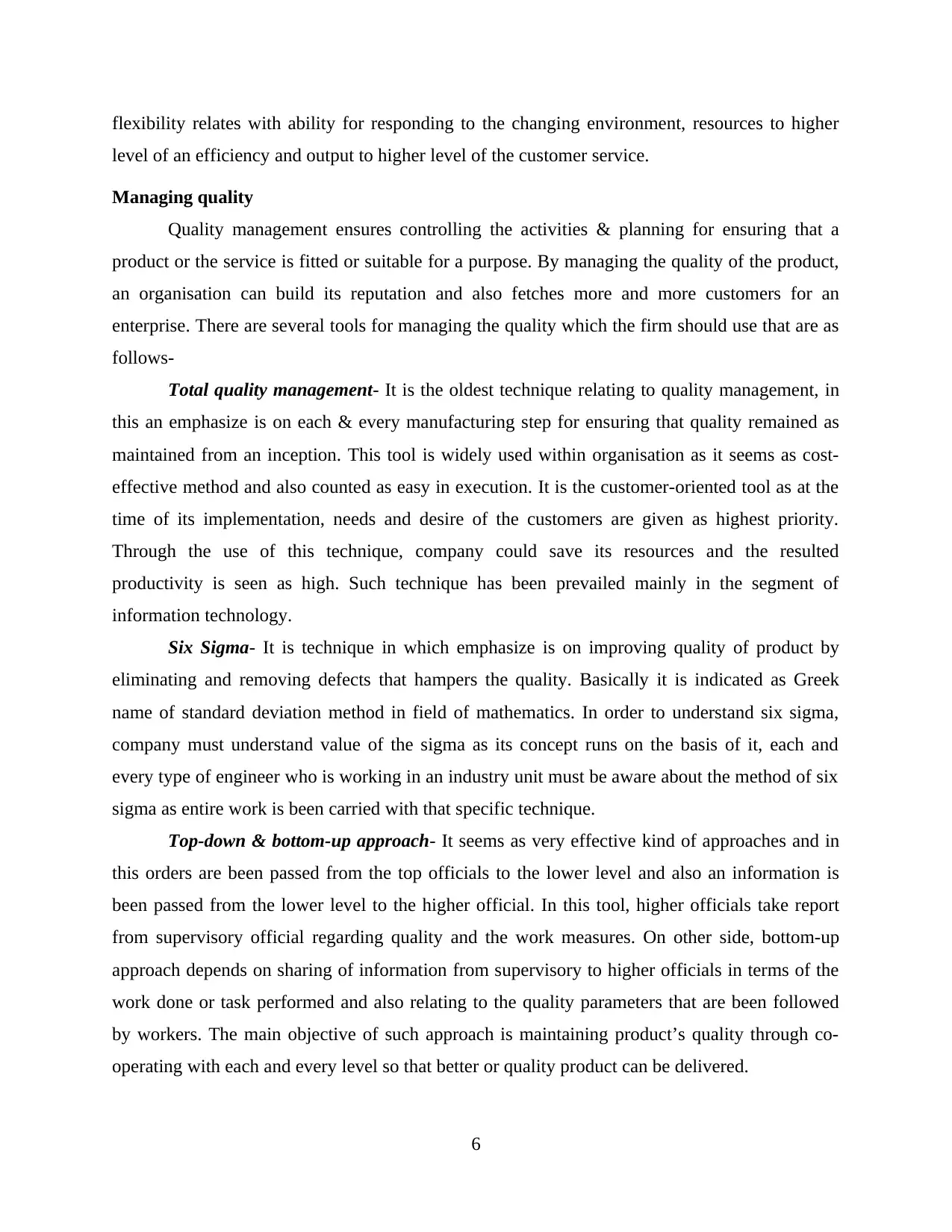
flexibility relates with ability for responding to the changing environment, resources to higher
level of an efficiency and output to higher level of the customer service.
Managing quality
Quality management ensures controlling the activities & planning for ensuring that a
product or the service is fitted or suitable for a purpose. By managing the quality of the product,
an organisation can build its reputation and also fetches more and more customers for an
enterprise. There are several tools for managing the quality which the firm should use that are as
follows-
Total quality management- It is the oldest technique relating to quality management, in
this an emphasize is on each & every manufacturing step for ensuring that quality remained as
maintained from an inception. This tool is widely used within organisation as it seems as cost-
effective method and also counted as easy in execution. It is the customer-oriented tool as at the
time of its implementation, needs and desire of the customers are given as highest priority.
Through the use of this technique, company could save its resources and the resulted
productivity is seen as high. Such technique has been prevailed mainly in the segment of
information technology.
Six Sigma- It is technique in which emphasize is on improving quality of product by
eliminating and removing defects that hampers the quality. Basically it is indicated as Greek
name of standard deviation method in field of mathematics. In order to understand six sigma,
company must understand value of the sigma as its concept runs on the basis of it, each and
every type of engineer who is working in an industry unit must be aware about the method of six
sigma as entire work is been carried with that specific technique.
Top-down & bottom-up approach- It seems as very effective kind of approaches and in
this orders are been passed from the top officials to the lower level and also an information is
been passed from the lower level to the higher official. In this tool, higher officials take report
from supervisory official regarding quality and the work measures. On other side, bottom-up
approach depends on sharing of information from supervisory to higher officials in terms of the
work done or task performed and also relating to the quality parameters that are been followed
by workers. The main objective of such approach is maintaining product’s quality through co-
operating with each and every level so that better or quality product can be delivered.
6
level of an efficiency and output to higher level of the customer service.
Managing quality
Quality management ensures controlling the activities & planning for ensuring that a
product or the service is fitted or suitable for a purpose. By managing the quality of the product,
an organisation can build its reputation and also fetches more and more customers for an
enterprise. There are several tools for managing the quality which the firm should use that are as
follows-
Total quality management- It is the oldest technique relating to quality management, in
this an emphasize is on each & every manufacturing step for ensuring that quality remained as
maintained from an inception. This tool is widely used within organisation as it seems as cost-
effective method and also counted as easy in execution. It is the customer-oriented tool as at the
time of its implementation, needs and desire of the customers are given as highest priority.
Through the use of this technique, company could save its resources and the resulted
productivity is seen as high. Such technique has been prevailed mainly in the segment of
information technology.
Six Sigma- It is technique in which emphasize is on improving quality of product by
eliminating and removing defects that hampers the quality. Basically it is indicated as Greek
name of standard deviation method in field of mathematics. In order to understand six sigma,
company must understand value of the sigma as its concept runs on the basis of it, each and
every type of engineer who is working in an industry unit must be aware about the method of six
sigma as entire work is been carried with that specific technique.
Top-down & bottom-up approach- It seems as very effective kind of approaches and in
this orders are been passed from the top officials to the lower level and also an information is
been passed from the lower level to the higher official. In this tool, higher officials take report
from supervisory official regarding quality and the work measures. On other side, bottom-up
approach depends on sharing of information from supervisory to higher officials in terms of the
work done or task performed and also relating to the quality parameters that are been followed
by workers. The main objective of such approach is maintaining product’s quality through co-
operating with each and every level so that better or quality product can be delivered.
6
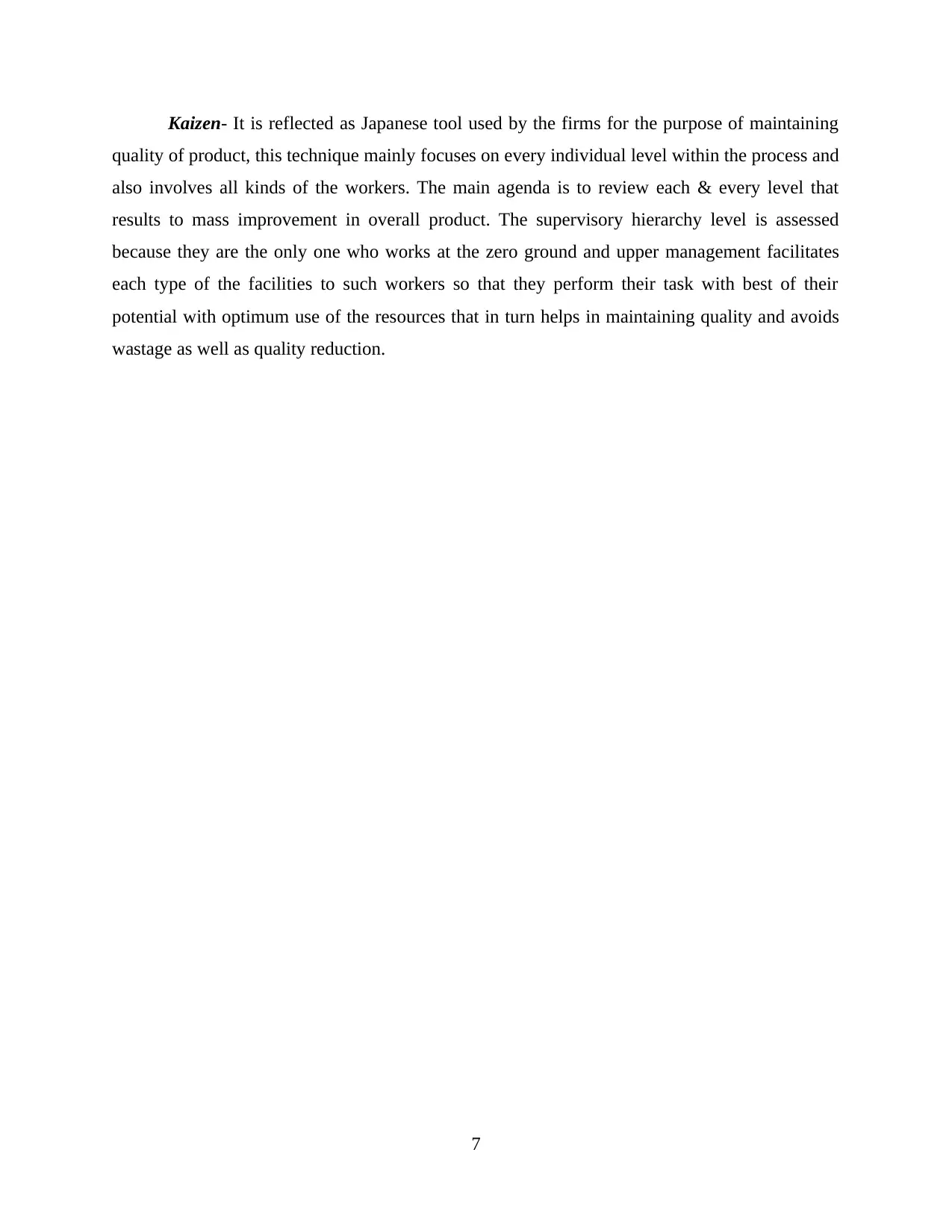
Kaizen- It is reflected as Japanese tool used by the firms for the purpose of maintaining
quality of product, this technique mainly focuses on every individual level within the process and
also involves all kinds of the workers. The main agenda is to review each & every level that
results to mass improvement in overall product. The supervisory hierarchy level is assessed
because they are the only one who works at the zero ground and upper management facilitates
each type of the facilities to such workers so that they perform their task with best of their
potential with optimum use of the resources that in turn helps in maintaining quality and avoids
wastage as well as quality reduction.
7
quality of product, this technique mainly focuses on every individual level within the process and
also involves all kinds of the workers. The main agenda is to review each & every level that
results to mass improvement in overall product. The supervisory hierarchy level is assessed
because they are the only one who works at the zero ground and upper management facilitates
each type of the facilities to such workers so that they perform their task with best of their
potential with optimum use of the resources that in turn helps in maintaining quality and avoids
wastage as well as quality reduction.
7
⊘ This is a preview!⊘
Do you want full access?
Subscribe today to unlock all pages.

Trusted by 1+ million students worldwide
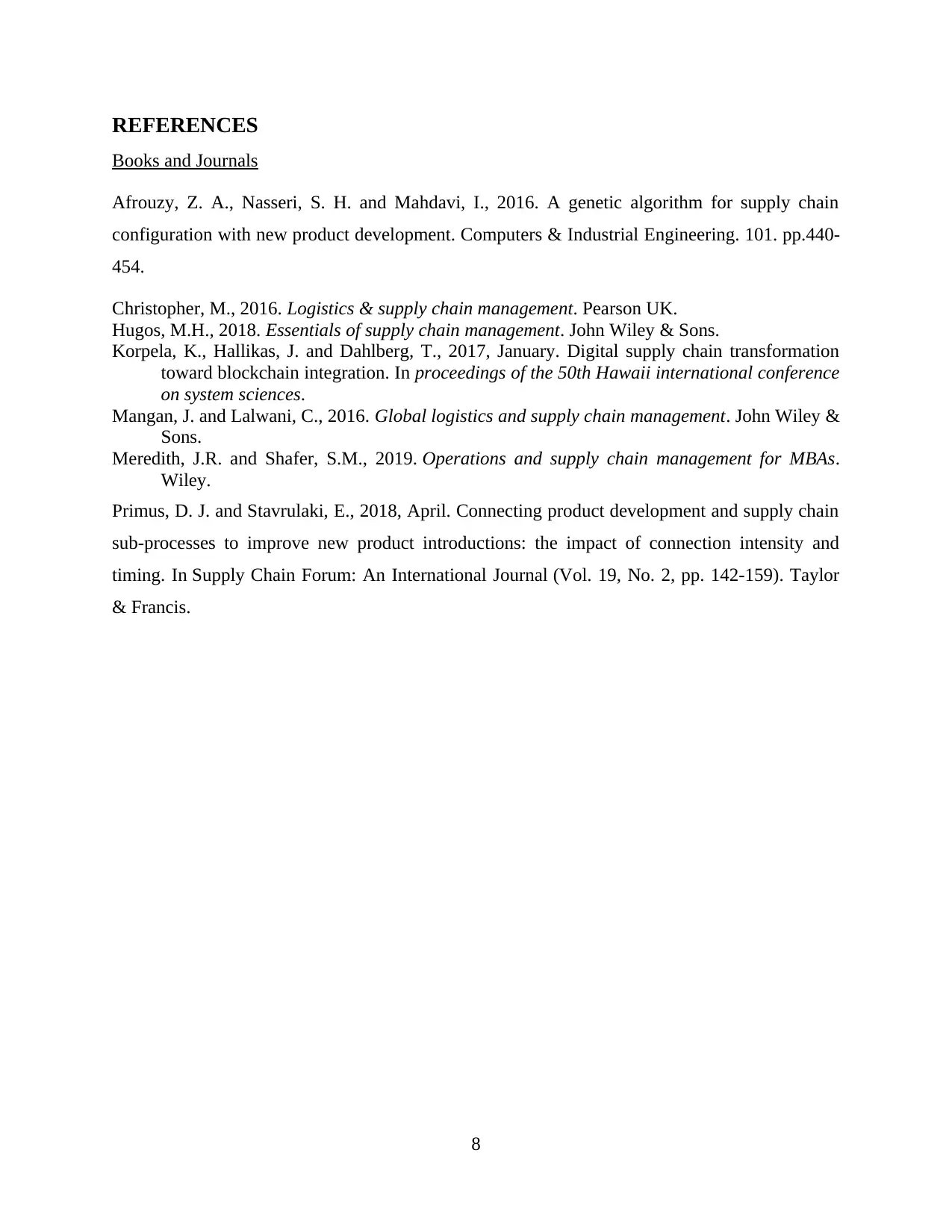
REFERENCES
Books and Journals
Afrouzy, Z. A., Nasseri, S. H. and Mahdavi, I., 2016. A genetic algorithm for supply chain
configuration with new product development. Computers & Industrial Engineering. 101. pp.440-
454.
Christopher, M., 2016. Logistics & supply chain management. Pearson UK.
Hugos, M.H., 2018. Essentials of supply chain management. John Wiley & Sons.
Korpela, K., Hallikas, J. and Dahlberg, T., 2017, January. Digital supply chain transformation
toward blockchain integration. In proceedings of the 50th Hawaii international conference
on system sciences.
Mangan, J. and Lalwani, C., 2016. Global logistics and supply chain management. John Wiley &
Sons.
Meredith, J.R. and Shafer, S.M., 2019. Operations and supply chain management for MBAs.
Wiley.
Primus, D. J. and Stavrulaki, E., 2018, April. Connecting product development and supply chain
sub-processes to improve new product introductions: the impact of connection intensity and
timing. In Supply Chain Forum: An International Journal (Vol. 19, No. 2, pp. 142-159). Taylor
& Francis.
8
Books and Journals
Afrouzy, Z. A., Nasseri, S. H. and Mahdavi, I., 2016. A genetic algorithm for supply chain
configuration with new product development. Computers & Industrial Engineering. 101. pp.440-
454.
Christopher, M., 2016. Logistics & supply chain management. Pearson UK.
Hugos, M.H., 2018. Essentials of supply chain management. John Wiley & Sons.
Korpela, K., Hallikas, J. and Dahlberg, T., 2017, January. Digital supply chain transformation
toward blockchain integration. In proceedings of the 50th Hawaii international conference
on system sciences.
Mangan, J. and Lalwani, C., 2016. Global logistics and supply chain management. John Wiley &
Sons.
Meredith, J.R. and Shafer, S.M., 2019. Operations and supply chain management for MBAs.
Wiley.
Primus, D. J. and Stavrulaki, E., 2018, April. Connecting product development and supply chain
sub-processes to improve new product introductions: the impact of connection intensity and
timing. In Supply Chain Forum: An International Journal (Vol. 19, No. 2, pp. 142-159). Taylor
& Francis.
8
1 out of 10
Related Documents
Your All-in-One AI-Powered Toolkit for Academic Success.
+13062052269
info@desklib.com
Available 24*7 on WhatsApp / Email
![[object Object]](/_next/static/media/star-bottom.7253800d.svg)
Unlock your academic potential
Copyright © 2020–2025 A2Z Services. All Rights Reserved. Developed and managed by ZUCOL.





